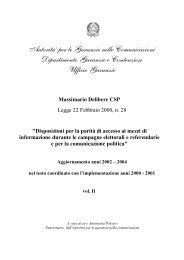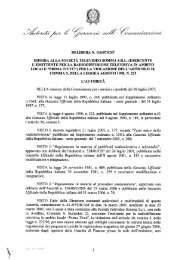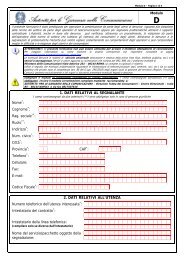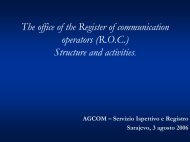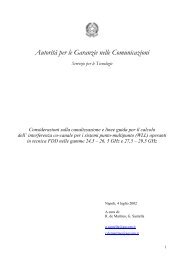Communications Regulatory Authority
Communications Regulatory Authority
Communications Regulatory Authority
Create successful ePaper yourself
Turn your PDF publications into a flip-book with our unique Google optimized e-Paper software.
generation networks also make possible the preparation of fixed-mobile integrated<br />
services that enable the operator to meet all the end user’s communication needs, i.e. the<br />
possibility to approach the customer with a single integrated offering<br />
(fixed/mobile/Internet/IPTV). For these reasons, the rules concerning the access to new<br />
generation networks are a crucial junction for the future structure of the sector.<br />
The regulatory Authorities thus find themselves in the situation of having to<br />
identify the proper balance that can, on the one hand, encourage investments in network<br />
innovation and, on the other, ensure the conditions suitable for guaranteeing free<br />
competition in the sector and the single markets making it up.<br />
The initiatives undertaken by the regulatory Authorities in recent years have, in<br />
particular, been conducive to a transition to a competition model based on the use of<br />
alternative infrastructure to that of the incumbent operator. The measures adopted in the<br />
various contexts depend inevitably on the country’s infrastructure situation, in particular<br />
on the presence or absence of alternative networks to those of the incumbent operator.<br />
In the United States, the prevailing trend is that of an easing of the regulatory<br />
constraints on infrastructure operators owing to the presence of a certain degree of<br />
competition within the networks.<br />
Falling within this regulatory strategy is the process of revision of the rules<br />
governing telecommunications services carried out by the Federal Communication<br />
Commission (FCC) to evaluate their adequacy for the changed market context<br />
(“Triennial Review”). The Triennial Review Remand Order, published by the FCC in<br />
early February 2005, removed some of the obligations that had previously been set for<br />
the local incumbent carriers (ILECs) regarding access of the alternative operators<br />
(CLECs) to the elements of their networks (Unbundled Network Element-Platform –<br />
UNE-P). Similarly, the FCC eliminated the obligation, also for the ILECs, to allow<br />
access to their broadband networks, under fair and non-discriminatory conditions and at<br />
prices regulated by the independent ISPs. Access to these networks will thus be the<br />
subject of free negotiation by the parties.<br />
Underlying these decisions is, as already mentioned, the changed US<br />
competitive context, which sees, among other things, the presence of local networks<br />
(especially cable) in alternative to the copper infrastructure used for providing<br />
broadband access services. In this framework, the FCC feels that the removal of the<br />
obligations in force will stimulate investments in the broadband network infrastructure<br />
by operators that do not have infrastructure of their own and that, even in the absence of<br />
regulatory obligations, there are reasons (of economic convenience) that will lead the<br />
ILECs to provide broadband connectivity services to independent ISPs under conditions<br />
that will meet their needs.<br />
More in general, even the Community regulatory approach, like that of the US,<br />
has the goal of stimulating an infrastructure type competition and not the mere resale by<br />
alternative operators of the incumbent carriers’ wholesale services; this goal must be<br />
reached in a context of national markets characterized by the presence of a few (if not<br />
7




